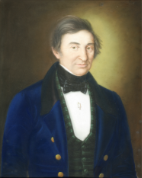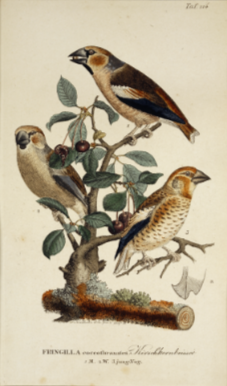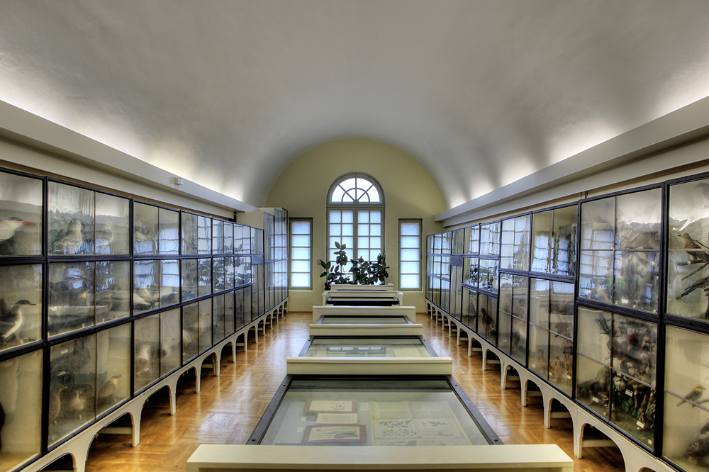
Johann Friederich Naumann (1780-1857) is probably the best known of the early German ornithologists, and was one of the founders of scientific ornithology in continental Europe. Naumann collected birds and their eggs, illustrated them, and wrote extensively about them — all while running the family farm and rearing his own brood of nine children.
Naumann’s collection eventually became too large for the family’s modest farm house so he sold the collection to Frederick Ferdinand, Duke of Anhalt-Köthen in 1821. As well as having plenty of space, the Duke was keen to own a ‘cabinet’ [1] and was happy to pay Naumann to curate the collection—a perfect arrangement for both parties. The museum, which occupies a side-wing of Köthen Castle, at Köthen, Germany (in the former GDR), has been open to the public since 1835.

I visited the Naumann Museum with three colleagues during the anniversary meeting of the DO-G at Halle in September/October this year. As ornithologists interested in the history of bird study, our visit to this extraordinary collection was an eye-opening experience. I am particularly grateful to the museum’s curator, Bernard Just, for showing us around and providing the photos for this blog post.

Naumann taught himself to paint, and as a teenager produced sophisticated and wonderfully mature watercolours to illustrate the bird books written by his father Johann Andreas Naumann (1744-1826). Later, J. F. Naumann produced his own ‘masterpiece’ Naturgeschichte der Vögel Deutschlands [The Natural History of the Birds of Germany] in 12 volumes (1822-1844), with a 13th volume—published posthumously in 1866—comprising 396 plates he had engraved himself [2].

The late Jürgen Haffer [3] referred to Naumann’s Natural History as the “titanic efforts of just one man,” and it was to remain the standard German ornithology text for decades. J. F. Naumann, along with Christian Ludwig Brehm and Friedrich Faber (who died young), were key players in what Haffer referred to as the ‘Golden Age of Central European ornithology’ (1820-1850). Together those three men “established a sound basis for the study of birds in this region and beyond” [4].
The Naumann Museum is now in desperate need of restoration and investment to secure its long-term future. The risk, as always, is that there is just not enough interest in such a collection and there will be insufficient funds to maintain it. As an absolute priority, the notes, the paintings. etc. all need to be scanned so, at the very least, digital copies of everything will be preserved.
There are few museums anywhere that are dedicated to the work of a single ornithologist. This one is truly extraordinary—a cornucopia of information documenting a key period in German ornithology. I was inspired, and if I could speak and read German, I’d be busy planning a biography of this remarkable man. In fact, a biography was published by Thomsen in 1957, but approaches to the history of science and ornithology have changed a great deal since then and J. F. Naumann deserves a new biography. Perhaps this is what is needed to generate investment in the museum. The ornithological world is waiting!

SOURCES
- Haffer J (2007) The development of ornithology in central Europe. J. Ornithol. 148 (Suppl.): S125-153.
- Haffer J, Huddle H, Hillcoat B (2014) The development of ornithology and species knowledge in central Europe. Bonn zoological Bulletin – Supplementum 59: 1–116.
-
Naumann JA (1820-1844) Johann Andreas Naumann’s, Naturgeschichte der Vögel Deutschlands, nach eigenen Erfahrungen entworfen. Leipzig: G. Fleischer.
- Stresemann E (1975) Ornithology: from Aristotle to the Present. Cambridge, Mass: Harvard University Press.
- Thomsen P (1957) Johann Friedrich Naumann, der Altmeister der deutschen Vogelkunde, sein Leben und seine Werke. Leipzig: J. A. Barthg. 212 pp.
Footnotes
- Cabinets of Curiosities became popular during the scientific revolution in Europe from 1600-1900. Initially private, these collections of biological, anthropological and geological artefacts eventually evolved into our national museums.
- digitally scanned originals of all 13 volumes are available for reading and download here at the fabulous Biodiversity Heritage Library online.
- see also Birkhead TR, Schulze-Hagen K (2010) Ibis 152: 867-868 for details of Haffer’s life and work.
- Quotation from Haffer (2007:S125); see also Stresemann (1975:306-8).
COMMENTS